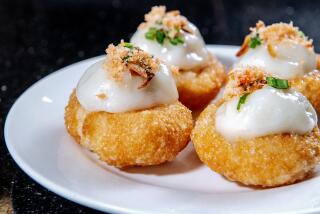Using Pummelos
- Share via
Pummelos vary in eating quality, depending on season and growing area. Fruits with green rinds can be good, but best flavor develops when the skin begins to turn yellow. Peak season in the Central Valley runs from December to March or April; in the Southland, fruit ripens a month later, and many smaller growers sometimes let it hang into the summer.
At market, look for heavy pummelos with a rich aroma. Medium-size fruits are best for eating; huge specimens, though much appreciated by Asians, tend to be dry and woody. Aficionados maintain that pummelos stored for a month or more improve in flavor and juiciness.
Pummelos aren’t suited to being cut in half and eaten with a spoon, like grapefruit, because the pulp doesn’t come out easily that way. Instead, filet a pummelo by slicing off the top and bottom as near as possible to the flesh and scoring the rind longitudinally, around the equator without cutting into the flesh. Strip off the peels, saving them for candying, and remove as much as possible of the bitter white pith. Tear the fruit ball in half, separate the segments and use knife and fingers to remove the membranes.
For an attractive presentation, arrange the segments in a circular pattern on a plate or use them in fruit salads.
Asians usually eat pummelos fresh, often with dips of salt, sugar and chile, which bring out the flavor. Dry, “ricey” pummelos are used in salads with chile and fish sauce. Chinese cooks also boil the rind and use it as a vegetable in stews with meat and fish, and Persians and Greeks make jam of the peel and juice.
Bangkok-Style Pummelo Salad (Yum Som-O)
Active Work and Total Preparation Time: 45 minutes
From India to the Philippines, many Asians make pummelo salads--a fine use for dry, “ricey” specimens. Bill Chutima and his wife, Dang, served this dish at Renu Nakorn, a renowned Thai restaurant in Norwalk that they owned until recently. Once the membranes of the pummelo segments have been removed, the firm, crisp pulp can be shredded into small pieces without dissolving. “We’d prefer a white-fleshed pummelo for this recipe, but any kind will do,” Chutima says. Ingredients such as tamarind pulp and palm sugar are available at Thai and other Asian groceries.
5 shrimp, peeled and deveined
Water
1 tablespoon tamarind pulp
2 tablespoons oil
2 shallots, sliced into fine ovals
6 cloves garlic, sliced into fine rounds
2 tablespoons fish sauce
1 tablespoon lime juice
1 tablespoon palm sugar
1 tablespoon Thai red chile paste
1 (1 1/4-pound) pummelo, cut into segments, membranes removed and shredded (about 2 1/2 cups)
6 ounces cooked boneless, skinless chicken, shredded
2 tablespoons toasted, shredded coconut
1 tablespoon ground roasted peanuts, for garnish
4 dried Thai red chiles, for garnish
* Add shrimp to small pan of simmering water and cook 2 minutes; drain and set aside.
* Place tamarind pulp in small bowl and add about 3 tablespoons warm water. Soak 20 minutes, stirring to help dissolve lump. Pour liquid through small, fine-meshed strainer into another small bowl and set aside.
* Heat oil in wok or frying pan over medium-high heat and fry shallots until crispy, 1 to 2 minutes; remove with slotted spoon and set aside. Fry garlic over medium heat until crispy, 1 to 2 minutes; remove and set aside.
* In large bowl, mix 1 tablespoon tamarind liquid (reserving rest for future use), along with fish sauce, lime juice, palm sugar and chile paste. Add pummelos, chicken, shrimp and coconut and toss to coat thoroughly.
* Serve garnished with peanuts, dried chiles, fried shallots and fried garlic.
4 servings. Each serving: 242 calories; 469 mg sodium; 49 mg cholesterol; 10 grams fat; 23 grams carbohydrates; 18 grams protein; 0.48 gram fiber.
Pummelo Gratin With Champagne and Sabayon
Active Work and Total Preparation Time: 40 minutes
Chef Gary Palm prepares this dish at the Mission Inn in Riverside, where he likes to experiment with exotic citrus, including pummelos, from the University of California’s astounding collection.
3 pummelos, each about the size of large grapefruit
1 pint blueberries
1 pint raspberries
2 pints strawberries
8 egg yolks
3 tablespoons sugar
1 cup champagne
Powdered sugar, for garnish
* Remove skin of pummelos and cut into thin strips. You want just surface of rind, not white pith. Blanch approximately 1/4 cup of rind strips in simmering water 3 minutes.
* Clean pith from pummelo segments, then remove membranes. Arrange segments around edges of 6 dessert plates. Place blueberries, raspberries and strawberries in center of each plate.
* Mix together egg yolks, 3 tablespoons sugar and 1 cup champagne. Whisk mixture together in top of double boiler set over, but not touching, simmering water until consistency thickens and ribbons form, about 6 minutes. Add blanched zest, optional, to sabayon and spoon evenly over fruit. Dust with powdered sugar and serve.
6 servings. Each serving: 431 calories; 18 mg sodium; 363 mg cholesterol; 8 grams fat; 59 grams carbohydrates; 7 grams protein; 3.30 grams fiber.


